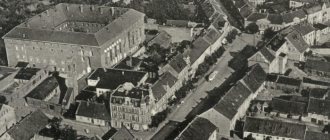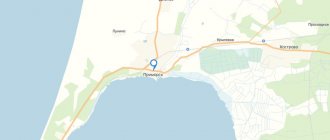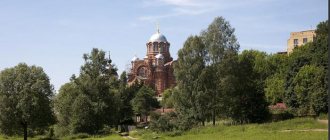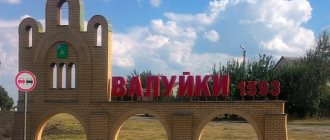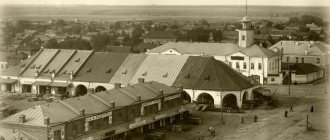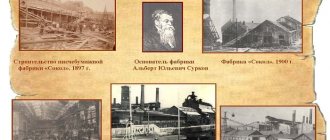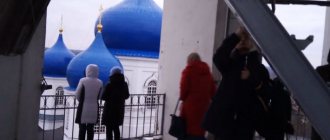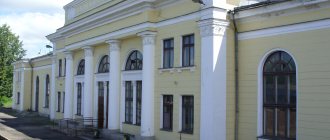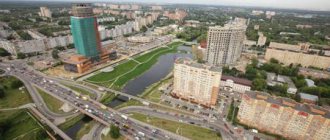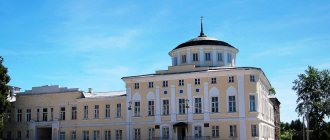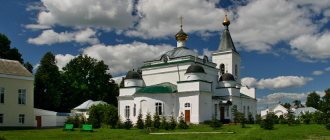About the history of the city
Interestingly, until 1947 Svetly was called Zimmerbude (which translated from German means “hut, shack”). It was a simple Prussian fishing village, the first mention of which in written sources dates back to the mid-15th century. And another nearby village - Paize (now the village of Komsomolsky) - is mentioned in a manuscript of 1305.
In the middle of the 15th century, on the site of modern Svetly, fortress walls were erected and the “fishing estate” of the Bishop of Zemland was founded. After the seizure of church lands by secular authorities, the estate came into the possession of the noble nobleman Oswald von Taubenheim, and in 1669 - Eberhard von Dunckelmann, the former tutor of King Frederick I.
The inhabitants of Zimmerbud were mainly engaged in fishing. They had no arable land, with the exception of home gardens. They kept livestock and cut hay in the meadows. In general, people lived here very poorly, and the village fully lived up to its name. The matter was aggravated by regular floods that occurred in these places. Gradually, the old bishop's castle also collapsed from them.
Medieval sources describe Zimmerbud as a collection of cramped and dirty huts with reed-covered roofs. Residents wore unsightly homemade clothes, which they spun, wove and sewed with their own hands. Everyone was very religious, although the nearest church was in Medenau (Logvino), and it was difficult to visit it due to bad roads.
Only in 1901 did Zimmerbud have its own small church: together with the neighboring villages of Paise and Nepleken, its residents formed their own church community. By this time, the village already looked much more civilized and nice. By the beginning of World War II, it was a small, neat village with more than a thousand residents and a new school built in the 20s; shop; tavern; bakery; Hotel "Waldschloschen" ("Forest House").
Soviet store located in an old German building
This building still stands. Behind it there used to be a lake with mineral water (mineral springs came out of the ground). A piece of this once mineral lake still remains behind the market, but overall it has already turned into a wetland.
The revitalization and growth of prosperity in Zimmerbud, Peise and Nepleken was facilitated by the construction of the Königsberg-Pillau shipping canal (it was in operation from 1894 to 1901). The floods stopped, permanent convenient harbors and pavements were established in fishing villages, and a power station appeared; the railroad came here. In Paisa, a sports society even started working and became extremely popular; a powerful football team was founded.
There were no military operations on the territory of provincial Zimmerbud, and therefore the village was not subject to destruction. After the war, in 1947, the village was renamed the village of Svetloye. In 1949 it became known as the working settlement of Svetly, and in 1955 it received the status of a city.
Soon after the war, thanks to the power plant and the canal, city-forming enterprises appeared in Svetloye: the fishing collective farm “For the Motherland!” and a fish canning plant and a ship repair plant. Their workers built the entire city. For a long time, for building materials, slag was taken from GRES-2, mixed with cement, poured between wooden slabs, and a monolith was obtained.
The most important attraction of Svetly is the Kaliningrad Sea Shipping Canal.
Light
As part of Germany, Peise and Zimmerbud
The village of Zimmerbude (which means “watch shop”), located on the site of the modern city of Svetly, was first mentioned in the chronicles of the Teutonic Order, dating back to the mid-15th century. However, there are earlier mentions of this area dating back to the beginning of the 14th century. The Fischhausen manuscript for 1305 mentions the Peise peninsula (“Poysart” is translated as territory, area near a forest), on which the settlement of the same name was located. From here, the Teutonic Knights invaded Prussia in the 1230s.
In 1306, by order of Bishop Bartholomew, the right was granted to begin settling new lands on the Zemland Peninsula from Paize. Paise was a poor settlement. The religion of the Prussians placed significant restrictions on them in their trades; they had sacred fields, groves and ponds where the Prussians could not cut down trees, plow the land or fish - Peter of Dusburg wrote about this in the 13th century. Fishing permits were issued by the German knightly order and officials; without such permits, fishing was prohibited. Nevertheless, fishing was the main craft of the inhabitants of Paise. Women weaved, spun, sewed clothes, and did housework.
Near Peise was the fishing village of Zimmerbude. In the chronicle of the master of the Teutonic Order of the 15th century, the castle of Kerauwe (Kemrove) is mentioned. Kemrove is a modified name for Zimmerau, this is the first mention of Zimmerbud. According to one version, in the area of Zimmerpuden, rich in forests, they were engaged in logging for the castles of the bay coast. An estate subsequently grew out of Kemrove, which belonged to the Zemland bishop. During the period of secularization of church lands, Bishop Georg von Pollentu exchanged the estate to Oswald von Taubenheim for part of the village of Pompen. Oswald von Taubenheim came from the most distinguished Zemland noble family. The Taubenhams owned Zimmerbud until 1661. The castle of the “Royal Fisherman's Estate” was located here, built in the middle of the 15th century.
In 1669, the estate was received as a reward by the former tutor of King Frederick I, Ebenhard von Dankelman. Since 1720, 16 land plots were assigned to Zimmerbuda, about 12 peasants and the same number of fishermen lived in the village. Residents, as before, were engaged in fishing, mainly for their own needs.
The castle of the “Royal Fisherman's Estate” has not survived; it was destroyed over time by the waters of the bay and time. After the castle disappeared, life for the residents of Zimmerbud worsened. Fishing could not provide a decent living. The peasants actually had no land, so they rarely kept livestock. The houses were cramped. Life was further complicated by the repeated floods from year to year.
Religion was an important part of village life. Services and religious ceremonies were held in Zimmerbud. The village did not have its own church; the residents were assigned to the parish in Medenau (now Logvino). But bad roads did not allow frequent visits to the church in Medenau; residents of Zimmerbud visited there only occasionally: for the baptism of children, for weddings and on major holidays, if the weather permitted. The rest of the time we attended church sermons held in the school building. In 1899, at the expense of the village of Medenau in Zimmerbud, a small church was built as a branch of the main temple. In the spring of 1901, one and a half thousand residents of Zimmerbude, Paise and Nepleken bought the church, forming their own church community.
From 1894 to 1901 The Koenigsberg-Pillau canal was built, the spit was filled in, and the water near the villages calmed down. Convenient harbors were built in fishing settlements, pavements were raised, and signal stations were equipped. Later, a power station was built, a railway with a new station was opened, two port berths and a feed mill were built, and motor boats were transferred from Pillau. All this revived life in the villages and led to an increase in the well-being of residents. Fishermen now have the opportunity to conveniently communicate with Koenigsberg.
The population of Zimmerbud in 1829 was 388 people, in 1844 – 460 people, 1858 – 634 people, 1905 – 797 people, in 1919 – 742 people. 209 people lived in Paisa in 1831, 305 people in 1844, 361 people in 1858.
In the 20s of the 20th century, a new school was built. In the 1930s, Zimmerbude became a fairly lively village. The Waldpshoschen hotel, bakery, tavern, gendarmerie post were located here, and the village midwife worked. The residents had their own church. People sold gastronomic and fishing goods. During this period, there were three small hotels in Paisa, a bread and butcher shop, and a department store. A sports society was organized, and football was the favorite sport.
During the Second World War
On April 25, 1945, after 60 days of battles, Soviet troops took the Pillau fortress, one of the strongholds of the Nazi fleet. This operation completed the final defeat of the Zemland group. The remnants of the group (up to 35,000 people) driven out of Pillau secured a foothold on the Baltic Spit (Friesche-Nerung), organizing a tight defense. The Soviet command decided to land a tactical assault force at two points to cross the spit: the first was concentrated in Pillau, the second in Paise-Zimmerbud, between which there were convenient berths for boats.
The first to enter the Frische-Nerung spit was a company under the command of senior lieutenant Vasily Stepanovich Yaltsev. The company operated as part of the marine battalion of the 487th separate disciplinary battalion of the Red Banner Baltic Fleet, led by Lieutenant Colonel A.O. Leibovich. V. S. Yaltsev’s company destroyed 250 Nazis and captured over 800 people; the company commander himself eliminated about 50 Germans and died heroically in battle. One of the streets in the city of Svetly was named after Vasily Yaltsev in 1970. There were no military operations directly on the territory of the modern city of Svetly, so Zimmerbud was not subject to significant destruction.
As part of the USSR, the city of Svetly
On July 30, 1945, the Paise-2 power plant was included in the Königsbergenergo Administration; in March 1947, it produced the first electricity, and on May 22, 1953, it was renamed GRES-2 - State District Power Plant. On September 1, 1945, the fish factory in Paisa began operations. In 1946, an elementary school was opened in the village, which was located in the priest’s house.
In 1947, Zimmerbud received a new name - Svetly. By decree of the Presidium of the Supreme Soviet of the RSFSR dated June 17, 1947, the Village Council was formed as part of the Primorsky district with its center in Svetly. In the same year, a cinema hall was opened in the village in the building of a former church (now it is the Sports House). On August 6, 1947, on the site of the harbor for small vessels, the Baltgosrybtrest ship repair base was founded, which in 1955 was renamed the Svetlovsky ship repair plant. In 1948, a seven-year school was opened in the former hotel building.
On August 1, 1949, by decision of the Kaliningrad Regional Executive Committee No. 758, the settlement of Svetly was transformed into a workers’ settlement of the same name.
In 1953, the first library began operating in the village of Svetly. On September 1 of the same year, secondary school No. 31 was built and opened on the street. Yaltseva (now vocational school). In 1955, a new clinic building was put into operation.
On October 6, 1955, the workers' village of Svetly was transformed into a city of district subordination by Decree of the Presidium of the Supreme Soviet of the RSFSR. In 1957, the House of Culture for Power Engineers opened in the city.
February 1, 1963 Svetly was classified as a city of regional subordination. In 1966, the city was awarded a Certificate of Honor from the Ministry of Public Utilities for its success in improvement. On November 27 of the same year, a vocational school for training ship repair workers was opened in Svetly. In the mid-1960s. The Burevestnik cinema welcomed its first spectators. In 1969, the new city hospital, designed for 120 beds, received its first patients.
On January 20, 1972, a Culture and Recreation Park opened in the city, located on the banks of the canal. In 1978, a monument to Lenin by sculptor N. A. Andreev was erected on the central square of Svetly. In the same year, a new telephone exchange with a capacity of 3 thousand numbers came into operation. In the 1970s, Sovetskaya Street divided the city of Svetly into two parts and connected two districts of the city - Komsomolsky and Central.
In 1995, a museum of the city of Svetly was opened in the building of the House of Culture.
Law of the Kaliningrad Region No. 423 of October 11, 2004 established the municipal formation “Svetlovsky Urban Okrug” with the administrative center in the city of Svetly.
Kaliningrad Sea Shipping Canal
This is a hydraulic structure located in the Kaliningrad Bay. It stretches 43 kilometers, from the military harbor of Baltiysk along the northern shore of the Kaliningrad Bay to the Kaliningrad port. The width of the canal is from 50 to 80 meters, and its depth is 9-10 meters.
The canal was fenced off from the bay by ten artificial artificial islands. They are overgrown with forest and protect the canal fairway from the waters and sediments of the bay. The canal is navigable year-round, although in winter it can be covered with a thin crust of ice. Vessels are up to 200 m long, with a draft of up to 8 m and a carrying capacity of up to 30 thousand tons.
Kaliningrad Sea Shipping Canal
In the city of Svetly, the Kaliningrad Sea Canal is bordered by a picturesque embankment. On warm and fine days, it always becomes the most popular public area in this city, where walkers, vacationers and fishermen spend their time.
Brandenburg Castle
This is a very ancient castle that amazed everyone with its majesty and wealth. It was erected in 1266. This giant is located on the shores of the Baltic Sea. The walls of the castle are quite strong and powerful and that is why it could withstand numerous attacks by enemies. Frequent fires caused a lot of damage to this castle. The entire territory of the castle was inhabited by fishermen, innkeepers, and artisans.
According to legend, one of the fragments of the Holy Cross, where Jesus was crucified, was kept in this castle. Today the castle is half destroyed.
The castle is located outside the city, 50 kilometers from Svetly in the village of Ushakovo.
Pavel Nakhimov Boulevard and the bust of this famous naval commander
Nakhimov Boulevard is a beautiful street-alley in the city of Svetly, created back in the early 60s by local city enthusiasts. It is small and cozy, ideal for walking and relaxing.
Bust of Pavel Nakhimov
A bust of the famous Russian admiral Pavel Stepanovich Nakhimov (1802-1855) was installed on the boulevard named after him in July 2015.
Nakhimov Boulevard
On the territory of the city of Svetly there is a colorful Nakhimov Boulevard. This place is ideal for city dwellers to walk; here you can always meet young mothers with their children.
There are only 10 houses on the boulevard, so it is quite small, but this does not prevent it from being also a historical monument. This title is explained by the fact that there are two more memorable places on the territory of the boulevard:
- A memorial sign in honor of the participants in the liquidation of the Chernobyl disaster.
- Bust of Admiral P.S. Nakhimov (the bust was installed in July 2015).
Mosaic panel “To Kaliningrad fishermen”
A large-scale mosaic panel dedicated to Kaliningrad fishermen is located on the northwestern and northeastern facades of the Atlantic department store in the city of Svetly. This is the work of husband-and-wife artists Yuri and Nelly Smirnyagin, created in 1967-1968. These masters created many masterpieces of the now bygone style of socialist realism.
The composition of the mosaic in Svetly consists of two interconnected parts. The first of them depicts the daily work of fishermen at sea; reflects the romance of the “sea soul” and the fishing profession. The second is the desire for this romance of youth: in it, young athletes run along the seashore, illuminated by sunlight. The mosaic is made of glazed ceramic tiles in white, grey, yellow, red, blue and brown.
Mosaic panel “To Kaliningrad fishermen”
In 2021, this mosaic panel was included in the unified state register of cultural heritage objects of the Russian Federation of local (municipal) significance.
Address: st. Gorky, 13th century.
Mosaic
There is a beautiful mosaic on the north-eastern and north-western walls of the Atlantic department stores, located at the intersection of Gorky and Sovetskaya streets.
On the one hand, it depicts sailors who overcome the ocean expanses, and on the other hand, it depicts the sun, which illuminates running people with its rays. The mosaic was created in the period from 1967 to 1968 and its authors are the artists Smirnyagin - Yuri and Nelli.
Memorial sign to participants in the liquidation of the Chernobyl disaster
A memorial sign to the liquidators of the accident at the Chernobyl nuclear power plant was installed in the city of Svetly on Nakhimov Boulevard. It is a memorial stone with a black plaque.
Memorial sign to participants in the liquidation of the Chernobyl disaster
Location: Nakhimov Boulevard.
Monument to Veterans of Local Wars
Local community activists erected a monument to veterans of local wars in the city of Svetly in 2007. It is a heptagonal flowerbed, in the center of which there are mounds of boulders at an angle, and irregularly shaped stone pillars are installed. Words with poetic wishes to all participants in the “hot spots” of the 20th-21st centuries are carved on the memorial plaque.
Monument to Veterans of Local Wars
Address: st. Soviet.
Memorial plaque to Vilory Buslovsky
Vilory Vilorievich Buslovsky was the commander of the SOBR of the Internal Affairs Directorate of the Kaliningrad Region, originally from the capital of Checheno-Ingushetia, Grozny, where he served in the police since 1989. After the separatists led by Dudayev came to power, Buslovsky and his colleagues from Moscow removed from Chechnya an archive with lists of the entire intelligence network of the local Ministry of Internal Affairs and the KGB.
During his subsequent service in the city of Svetly, Vilory Vilorevich went on long business trips to Chechnya five times, taking part in both the first and second Chechen wars. Having received the “maroon beret,” Buslovsky was repeatedly shell-shocked and wounded, received the medal “For Courage,” three Orders of Courage, and the Order of Merit for the Fatherland.
On September 14, 2000, the Ural truck in which he was traveling was blown up by Chechen militants with a radio-controlled land mine, and the officer died at the age of 36. A memorial plaque in his honor was installed in the city of Svetly on the building of the Russian Ministry of Internal Affairs for the Svetlovsky urban district.
Address: st. Mira, 6.
From Kaliningrad to Svetly by car
To get on the highway to Svetly, you need to move along Dmitry Donskoy Street, Pobeda Avenue, then turn onto Baltic Highway. Along the way you will meet the settlements of Vzmorye and Volochaevskoye, and from there it’s a stone’s throw to your destination. The road is quite simple. The journey will take approximately 40 minutes. The distance from Kaliningrad to Svetly by car is 27 km.
The road is two-lane, one lane for traffic in each direction. Car traffic is quite sparse, there are always opportunities for overtaking.
Below is the route on the map.
Rent a Car
It is convenient to move around the Kaliningrad region with a rented car: it is compact, the distances between interesting cities are short. For those who prefer individual comfort, there are several rental companies. Among the possible options there are cars and economy and premium class.
The cost depends on the company, the class of the car, its technical equipment, the duration of the rental and some other factors. As a rule, taxes and insurance are included in the price, but fines and gasoline are paid separately. A cash deposit is required, which is returned upon completion of the lease.
The usual requirements for drivers include being at least 21–23 years old and having at least 3 years of driving experience. Variations are possible. The car is provided after 100% prepayment. Cash and bank cards are accepted for payment. Fines will be charged for returning a vehicle in improper condition.
You can choose a car that will completely suit you in terms of comfort, spaciousness and equipment using the Rentalcars aggregator.
Memorial plaque to Vasily Yaltsev
This memorial sign reminds us that on April 25, 1945, Marine Senior Lieutenant Vasily Stepanovich Yaltsev commanded an assault group that landed on the Frische-Nerung Spit (Baltic Spit). The sailors of the Baltic Fleet fought desperately in this battle and won, but their commander died on April 26, 1945 from a sniper’s bullet. The 30-year-old hero Vasily Yaltsev did not live long enough to see the Victory.
Memorial plaque to Vasily Yaltsev
Address: st. Yaltseva, 5.
Economy
- LLC "Lukoil - Kaliningradmorneft": production support base for oil production at sea and on land, LLC "Lukoil-KNT": integrated oil terminal, storage, transshipment of liquid petroleum products;
- CJSC Sodrugestvo-Soya - deep processing of oil-containing crops;
- LLC "Kliver" - a plant for the production of building metal structures;
- Vivo-Porte LLC - production of interior doors;
- LLC "Optim-Crane" https://www.optim-crane.ru - production of support and suspended bridge cranes, as well as gantry, cantilever, special ones of various lifting capacities and operating modes;
- LLC "Regio-Express" https://regio-express.ru/ - passenger transportation;
- Fish farm "For the Motherland" - fish production and processing;
- OJSC "Svetlovsk enterprise "Era" - carries out electrical installation work, repair of electrical equipment, measurements of electrical equipment parameters, repair of river and sea register vessels;
- OGUP "Zapremmash" - repair and manufacture of ship and fish processing equipment;
- CJSC "Mezhkolkhoznaya production base" - ship repair, port services, maintenance and supply of the fishing fleet;
- JSC "Ship repair Baltika" - ship repairs, port services;
- CJSC "BaltNafta" - transshipment of petroleum products;
- Creon LLC - fish grinding, canned food production.
- Svetlovsky Meat Products Plant LLC - production of meat products and sausages.
- LLC "BalticFishIndustry" - fish processing plant
Monument to V.I. Lenin
The monument to the leader of the Communist Party and founder of the Soviet state, Vladimir Ilyich Lenin, was erected in the city of Svetly in 1973. In our time (in 2007) it was recognized as an object of cultural heritage of local (municipal) significance.
Monument to V.I. Lenin
Address: st. Soviet.
Dark history in the city of Light
At the end of June this year, many federal and regional media reported on Afghan veteran from the Kaliningrad region Valery Filippov
, who came to Moscow and left his jacket with military awards at the reception of the President of the Russian Federation.
It was reported that the military pensioner, who had served his Motherland for a quarter of a century, made this demonstrative gesture out of despair, protesting against the arbitrariness of officials.
Actually, the former military pilot has two complaints against the authorities: a leaking roof and 10 acres of land, which they refused to provide to him as a combat veteran.
Valery Filippov lives with his 90-year-old mother Antonina Andreevna. During the Great Patriotic War, she protected the skies of Moscow from enemies: according to her son, “with the rank of corporal she served in the air defense of the Moscow Military District from the 41st to the 45th.”
Valery’s father, Alexander Filippov, a senior lieutenant of tank forces who fought from 1938 to 1945, also repaid the debt to the Motherland, as journalists write. And elder brother Yuri, a retired lieutenant colonel, who served in the Far East for 26 years.
«My brother was on combat duty on the aircraft carrier Minsk and took part in military campaigns from India to Vladivostok.
“Valery says on his YouTube page.
There he also talks a lot about himself, but we will return to these facts below.
Judging by the information provided by journalists, Valery Alekseevich was a former military pilot, a reserve captain, fought in Afghanistan, and resigned from the legendary Alexander Pokryshkin Guards Fighter Aviation Regiment, in his own words, due to illness.
He now lives in the city of Svetly, Kaliningrad region, in a two-story house on a street with the symbolic name Sovetskaya.
For the last eight years, he has been fighting mainly with officials, as he himself admits, for the rights of his mother, who “deserved the human conditions in the apartment.” The man claims that due to a leaky slate roof and collapsed gutters, the walls of the home where he lives with his mother are saturated with ineradicable mold. Representatives of the local administration ignored numerous requests from an elderly woman to repair the roof for many years.
Several years ago, Filippov wanted to improve his living conditions by building his own house, for which he decided to take advantage of the law giving him and his mother the right to receive ten acres of land. However, while there was an exhausting struggle with the land committee, the architect and other services, the law lost force. And the military pensioner was not put on the queue, writes Novaya Gazeta.
For justice, the retired captain went straight to Ilyinka, 23, to Dmitry Medvedev’s reception room, where on June 24 he laid out all the family orders and medals on the table.
“I fought in Afghanistan and Vietnam. Who were we fighting against? What have we achieved in life? We can't defeat the officials! But I wasn't taught to give up
! ”- this is how Filippov explained his action.
He said: if his actions do not have an effect, he will secede from Russia: “ I don’t want to live in this country anymore, with this state, they’ve brought me to this state.”
».
However, the image of an uncompromising fighter against bureaucratic lawlessness faded somewhat when the SP correspondent tried to find out the details of this confrontation. Everything turned out to be not so simple.
Indeed, based on the federal law “On the Status of Military Personnel,” adopted in 1998, Valery Filippov, being discharged from military service, had the right to receive a plot of land for individual construction. And he wrote such a statement in August 2004. True, living in the city of Svetly, he contacted the Kaliningrad mayor’s office.
«He even indicated specific streets - Tchaikovsky, Baku and Yaltinskaya, where he would like to receive land
Vladimir Nikitin, Commissioner for Human Rights in the Kaliningrad Region,
explained to SP .
“ But these streets are located in the very center of the city, where individual construction is not taking place at all
.”
According to Nikitin, “ Filippov was sent a written response with a detailed explanation of why his request could not be granted. The refusal was motivated by the fact that on Tchaikovsky Street there are only kindergartens, and on Baku and Yaltinskaya streets there are public gardens, moreover, there are no engineering supplies there, and these areas fall within the sanitary protection zone of industrial enterprises
».
But the correspondence with the Kaliningrad mayor’s office did not end there: Filippov continued to demand a land plot in this city. He did not give up his dream of moving to the capital of the regional center even when the provision on the provision of plots of land was removed from the law “On the Status of Military Personnel.” This happened on January 1, 2005.
In the end, the pensioner was made to understand that in Kaliningrad there are people in need of improved living conditions, and he is not on this list.
«Filippov was advised to register at his place of residence, that is, in the city of Svetly, and raise the issue of land for building a house with the local administration. The mayor of Kaliningrad (then he was Yuri Savenko) even wrote a petition to the head of Svetly about this, asked to put himself in the position of a veteran and allocate him a plot of land on the territory of the municipality
“said the human rights ombudsman for the region.
The "SP" correspondent turned for clarification to the current head of the administration of the Svetlovsky urban district, Sergei Lyutarevich
.
But the official’s answer was truly puzzling. According to him, Filippov is “an adventurer
” who only “
plays the role of a truth-seeker
,” while he himself “
lives at the expense of his disabled mother
.”
«What kind of military background he has still needs to be checked. He likes to show them off for any reason: they say he is a hero, and the authorities are bastards
“,” says Lutarevich.
The mayor assured that Filippov never contacted the administration about the land plot. His complaints boiled down to a leaking roof and dampness in the apartment.
“SP”: — What prevented us from solving this problem in a reasonable time?
?
— You see, in the house where he lives with his mother, most of the apartments have been privatized, including Filippov’s apartment. In this case, all repair work is carried out partly at the expense of the residents, partly with money from the municipal budget. Filippov was asked to collect signatures from his neighbors that they agreed to pay for part of the work to replace the roof, but he either forgot or didn’t want to...
“SP”: — Before his trip to Moscow, he complained that the local authorities had driven him to despair. You don't accept his reproaches
?
- He is a good artist. But why did he go to Moscow right now? We renovated the apartment for him last year (I gave him my personal money). We checked - everything was done conscientiously. The roof and gutters were also replaced. Why was it necessary to stage this whole performance?
“SP”: - Sergey Nikolaevich, what is the fate of the awards that Filippov took to Moscow
?
- The rewards have been returned. Now they are in Kaliningrad with the governor, but naturally they will be handed over to the owners in the near future. True, we cannot find Antonina Andreevna yet, she is not at home and where she is is unknown. By the way, Filippov took his mother’s awards without her knowledge.
Head of the Legal Department of the Administration of the Svetlovsky Urban District Nikolay Mamchenko
told SP that next Monday the government of the Kaliningrad region will release an official statement regarding this scandalous situation.
According to him, the act sent from Moscow along with the awards states that Filippov left in the reception his Air Force captain’s jacket with the Order “For Service to the Motherland in the Armed Forces of the USSR”, the badge of an internationalist warrior and seven anniversary medals. And also his mother’s civilian jacket with the Order of the Patriotic War, a veteran of labor medal and seven anniversary medals.
Mamchenko also cited several facts from the biography of the Afghan veteran. In particular, at one time Filippov graduated from the Kaliningrad Technical Aviation School. I did not receive a higher education, so I only rose to the rank of captain. He was indeed a participant in the Afghan events, but did not fly combat missions, since he served as technical personnel. Resigned due to length of service. He lived in Kaliningrad, then moved to Svetly and settled in his mother’s apartment. He has two adult children - a daughter and a son.
In his numerous interviews on the Internet, Valery Alekseevich speaks sparingly about Afghanistan: that he was there “ for just over a year from 1985 to 1986.”
th,” and that it was “
a little scary
” because they “
fell
.”
To the question: where else did you serve? He admits: “ Many places: in Transbaikalia, Mongolia, and Vietnam
" But Filippov talks especially enthusiastically about a certain mysterious operation in the Baltic states:
«He even fought in Estonia, although no one had heard of this war. In 1991 and 1992, I drove through the forests the “forest brothers” - Estonian illegal armed groups. They took away their weapons, which they had stolen from a military construction school. We shot at them, but we had orders not to kill. And then they captured the military airfield in Pärnu. We liberated the airfield in Pärnu
».
In the city Council of Veterans, however, as it turned out, they know nothing about the military merits of their fellow countryman.
«Filippov never contacted us
,”
Chairman of the public organization Alexander Romanov
.
“ But I know him, albeit indirectly, since I have not had contact with him personally.
I once ran into him in our social support department - he was very excited. Then, when he left, I asked: “Who is this?” They told me that there is such a person who calls himself an Afghan warrior, who constantly goes to them, downloads his license .”
According to Romanov, he does not understand why Filippov, as a military pensioner, never came to the Veterans Council:
«They would definitely help him, but he prefers to act on his own. Perhaps due to his character, perhaps due to his health, perhaps because of our life, he took such a position
…»
What a confusing story!
It must be admitted that Valery Filippov is not the first to return awards. An 87-year-old front-line soldier did it before him
from the Voronezh region
Vasily Zasorin
, who was denied housing by local authorities as part of a special presidential program.
And 83-year-old
Great Patriotic War veteran
Anton Karavanets
wrote a letter to American President Barack Obama asking to be accepted in America after the St. Petersburg authorities refused him housing on the grounds that he had not lived in the city for the required 10 years.
But for some reason the Kaliningrad story looks more like a farce than a human tragedy.
In the photo nr2.ru: Valery Filippov (left) together with his brother Yuri arrived in Moscow to return military awards to the president
House of Culture and City Museum
In the very center of the city of Svetly, behind the square with Ilyich, stands the city House of Culture. It is a fine example of a public building in the style of Stalinist architecture. Despite the fact that its construction was completed after the death of the head of the USSR: the cultural center opened in 1957.
Its construction began in the early 50s, on the initiative of the management of GRES-2. But the foundation sank into the ground a year after it was poured. It turned out that a German mill had previously stood on this very spot, and the foundation turned out to be filled with waste and dust that the Germans had dumped for years not far from the mill. Construction was delayed, and only in 1957 the House of Culture - a solid building in the Stalinist style with spacious halls, columns, massive wide staircases - was put into operation.
House of Culture and City Museum
In 1971, the Palace of Culture was awarded the status of a “Palace of Culture of the first category”. The number of seats in its auditorium is 250.
In our era, the city cultural center is part of the “Cultural and Youth Center” association (together with the teenage and youth club “Fakel” and a museum with an exhibition hall, equipped in the building of the cultural center). The museum clearly and entertainingly tells about the history of the city and region, about outstanding fellow countrymen.
The staff of the Palace of Culture organizes concerts and folk festivals on calendar holidays: New Year and Christmas, Maslenitsa, City Day - Fisherman's Day, on Victory Day on May 9.
Kalinin Street leads from the House of Culture - the first street built in Svetly after the war. The houses on it are two-story, solid and warm. It intersects with a street that is located almost near the forest, but is called Central.
Address: st. Kalinina, 2.
Svetly - the city of victorious socialism
- In contact with
- Telegram
- Link
There is almost no German housing stock in Svetly; it is a creation of post-war Soviet reality. Local architecture is a cocktail of post-war buildings, five-story panel buildings from the 70s and 80s, and several new apartment buildings from the 2000s. It’s not for nothing that Svetly is called the city of victorious socialism.
There will be a new city here
The impetus for the emergence of the city was the construction of a power plant, which is now called GRES2. Residents of Königsberg and the village of Zimmerbude worked on it on a watch basis. A railway and a military unit appeared, so the economic situation of the small village was decent.
The Soviet government did not transport specialists to GRES2 and built the city of Svetly in 10 years on the site of Zimmerbud. Post-war technologies did not allow the installation of piles on swampy soils, so good-quality German houses that stood on solid ground were demolished and apartment buildings were erected in their place.
House of Culture on Trash
In the very center of Svetly there is a square with Ilyich, behind it is the House of Culture. Shabby on the outside, but on the inside it's pretty much okay. The need for a club arose immediately: after the war, the village was populated by young people. In the early 50s, the management of GRES2 decided to build a real club. It took a long time to build, the foundation failed a year after it was poured. It turned out that there was a German mill on this site, and the new building was erected on the waste and dust that the Germans stored near the mill. In 1957, the House of Culture was commissioned; it turned out to be a solid building in the Stalinist style with huge halls, columns, and massive wide staircases. There is a city museum in the House of Culture. Its director Tatyana Mekhannikova gave us a tour of the city.
Build yourself a home
Kalinin Street leads from the House of Culture - the first street built after the war. The houses here are two-story, solid and warm. It intersects with a street that is located almost near the forest and is called Central for some reason. Here are houses built using the “Gorky” method.
After the war, thanks to GRES2 and the canal, city-forming enterprises immediately appeared in Svetloye: a fish canning plant, a fishing collective farm “For the Motherland!”, and a ship repair plant. Their workers built the entire city. For construction, they took slag from State District Power Plant 2, mixed it with cement, poured it between wooden slabs, and a monolith was obtained. This is harmful to health: the slag constantly emits harmful gases, but there was no other building material after the war. People from enterprises worked a certain number of hours at a construction site on their weekends and vacations, and then received housing in the same houses. That is, labor was free.
There is a vocational school on Central Street. Previously, there were two of them in Svetly: one trained workers for the ship repair plant, the second trained construction workers. Now this is a single institution where mostly graduates of orphanages and boarding schools study; they are sent here to support them until the army and give them at least some kind of specialty.
Living attraction
A dome is visible in the forest. This is the Orthodox Church of the Annunciation of the Blessed Virgin Mary, built about twenty years ago. Previously, the church was painted, whitewashed, it was elegant, but now all resources have been transferred to the central church. The functions of the churches were divided: funerals are held in the old church, weddings are held in the new one. In addition to the church, in the forest there is a hospital, a kindergarten and one of the two sports school buildings with a stadium. The hospital in Svetly is a vivid example of regional healthcare: the institution is withering and shrinking. Recently, the maternity hospital in Svetly was closed.
Svetlovsk sports school has 2 buildings and 2 stadiums. It is financed extremely poorly, and, according to rumors, the new mayor is considering closing it in order to save the city budget. Children at the school play football, volleyball, basketball, athletics, freestyle wrestling and rowing - the last two types give the status of an Olympic reserve school. The rowers do not have their own base, the boats are stored on the territory, results are achieved only through their own and the coach’s enthusiasm. Svetly’s living “landmark” is an active athlete, Honored Master of Sports, Dmitry Rozinkevich.
In the bright center
On the central square there is a post office, a market, a new entertainment center and a department store: a legacy of Soviet trade. A new church stands out, an Orthodox church in the name of the Holy Great Martyr Barbara, built with donations. Inside are frescoes painted by artists sent by the diocese from a special church art school. Behind the church is the building of the parish school.
Two interesting buildings are located near the central square. One is an abandoned barracks where the Germans had a stable and, after the war, a kindergarten. Children were constantly catching colds on the concrete floor of the barracks-kindergarten. The manager (she is still alive) went to Kaliningrad to the big boss to knock out the floor covering. The boss had a beautiful carpet in his office. The teacher said: “Look how nice your chrome boots are! Why do you need a carpet? Give it to kindergarten!” The boss had no choice but to hand over the carpet. The manager carried the carpet to Svetly.
The second is a nearby building, which was the Germans’ hotel “Waldschloschen” (“Forest Castle House”). Behind it there was a lake with mineral water, mineral springs flowed, and there was a complex system of connecting the lake with a canal. Therefore, the village was considered a recreational area of local importance. A piece of the once mineral lake still remains behind the market. About 20 years ago there were crayfish in it, there was a green wasteland around it - a city recreation area with willows and willows, and an ice skating rink in winter. The market owner built a stone wall along the perimeter of the lake, disrupting the drainage. Now the lake is turning into a swamp.
PASTORA'S HOUSE
Gorky Street was the entrance to the village for the Germans. The pastor's house has miraculously survived here. Nearby is the second building of the Svetlovsk sports school, which formerly housed a Catholic church. After the war, a cinema was organized in the temple due to good acoustics. The bell tower stood separately from the church; after the war, a pub settled in it. Extensions were constantly being made to the church; after the cinema, it was converted into the Sports House of the shipyard. When the plant became unable to maintain it, the building was given to a sports school.
Destined to survive
Due to its location - along the fairway of the Kaliningrad Sea Canal - Svetly was doomed to become an industrial center. The city is three kilometers long and one and a half kilometers wide. There was an opinion that the canal was built by Russian prisoners in 1914. In fact, the canal was built by the Germans, construction lasted 10 years, the first ship passed through it in 1901. Since then, the entire industry has been pressing towards the waterway.
Along the entire length of the canal, not counting the 500 meters of the city promenade, there are enterprises: SodruzhestvoSoya, Lukoil, ship repair, State District Power Plant 2, fish canning plant and others. Residents of Svetly breathe in the emissions from these enterprises. It has the highest rates of childhood asthma and leukemia in the region, and 1st place in the region for oncology and strokes. Baltnafta, contrary to all norms, located its production facilities 120 meters from the nearest residential building.
The city has an active population that is trying to fight for its survival. People filed a lawsuit against Baltnaft in the Strasbourg court. The application was accepted and considered, but judges from Strasbourg cannot come to Svetly and see the situation with their own eyes, so they sent all requests to Moscow. And in Moscow they were told that all the rules had been followed. Moscow officials cannot see how close hazardous production is to residential buildings. In the process of fighting Baltnafta, the population of Svetly invited an independent expert, who was very surprised that people still lived in the city. But he said that the townspeople are saved by the city’s location between the forest and the canal: the forest absorbs some of the pollution, and the wind rose in the canal partially removes emissions.
Sad signs
The city stadium and park are located along the canal. In the park, the city authorities sold the territory to certain entrepreneurs who began building an incomprehensible concrete monster. This unfinished building has been standing for five years now. It was chosen by drug addicts and homeless people. The reason for the unfinished construction: the soil was swampy, it was necessary to drive concrete piles using a cunning system. But unfortunate entrepreneurs did not carry out geological survey work and used cheap technology. The structure floated along with the parapet. The fate of the park is in doubt. By the way, many microdistricts of Svetly were built on filled-in swamps. That’s why the road leading into the city is uneven, wavy, periodically washed away, and the asphalt swells.
From the park to the House of Culture there is Nakhimov Boulevard, created in the early 60s by city enthusiasts. Rare trees brought from old German estates are planted here. In the depths of the boulevard there is a memorial sign to the Chernobyl victims. It, like the monument to internationalist soldiers on Sovetskaya Street, was built by social activists. The youth of Svetly made a sign: they dragged boulders and stacked them, simulating an explosion. Rallies are held here on the day of the withdrawal of troops from Afghanistan and on the anniversary of the Chernobyl disaster on April 26.
Failed to explode
Along the ugliest road we approach State District Power Plant 2, where, in fact, the city of Svetly began. For many years, all the slag from GRES2 was poured into a nearby swamp through a special pipe. The master of it all
There is a high voltage line running through it. And in this place there are also residential buildings, which are collectively called the “13th microdistrict” - strokes and oncology among residents are off the charts. Nearby are Baltnafta, a fire department and a small chocolate factory, Edinstvo LLC.
GRES2 is impressive in its scale! Before the war, it was second in Europe in terms of power, territory and technological equipment, and second in Germany. The station was designed by a German architect, who at the end of the war, on Hitler’s instructions, had to destroy industrial enterprises in Prussia so that they would not fall to the Russians. He felt sorry for blowing up his brainchild. The station was mined and they were waiting for the order to explode when the Russians entered the village. But the Soviet troops stopped in Izhevsk, which German intelligence reported to the command, and the Germans left Zimmerbud. When our troops entered the village, there was no one to fight with. A special group sent from Moscow approached the station undetected, disarmed the guards and cleared it of mines.
In Soviet times, graduates of all energy universities in the country underwent internships at the station - there was no more advanced equipment yet, even in Europe. In 1977 - 1978 the station was transferred from coal to liquid fuel. Today, GRES2 practically does not work, only in winter it provides the city with heat and hot water. But it remains a strategic facility; a staff of leading specialists is kept there in case it needs to be launched.
Homeland of "Bank No. 19"
We drive through a small forest to the former village of Paise, in the Komsomolsky microdistrict. The forest hides several enterprises: a plant for repairing small-tonnage ships, the Koenigtransavto enterprise, a factory for assembling cabinet furniture, Zapmebelplus LLC. Behind the forest, the railway branches into many tracks - this is a settling tank for fuel oil, oil tanks and other industrial cargo. A big problem for city residents: at night, when carriages are moving, no transport, including ambulances, can get from one part of the city to another. Previously, carriages blocked the road during the day, but the townspeople were indignant, and now they can pass through during the day.
From the road you can see a large military unit with a perimeter of 14 km. The Germans had this arsenal. Its internal territory consists of 22 railway lines, on each of which there are 22 bunkers, where the Germans stored weapons, and in our time - Baltic Fleet mines. Not a single air bomb could bomb these bunkers. The camouflage forest is an impenetrable thicket.
The Komsomolsky microdistrict was built after the war by the Baltic fish canning plant, which is located here. The territory of the plant is very large, overlooking the canal. It was once the second largest fish canning enterprise in the USSR. Many people remember the famous “Can No. 19” - “Sardines in Oil”. They were exported in olive oil. For Soviet citizens, sardines were produced in regular vegetable form. These were very tasty canned goods, famous throughout the USSR, which were obtained through connections. The plant produced all types of products - salted fish in barrels, in buckets, in jars, fried, steamed, pickled, freshly prepared fish. About 2,500 workers worked here. Today - 170 people.
Many other Svetly enterprises are going through difficult times. At the Svetlovsky shipyard there used to be 3,000 workers along with contractors, today there are about 500 workers. Sometimes the Kruzenshtern and Sedov are still repaired here.
Fishing farm “For the Motherland!” in Soviet times, it had 40 ocean-going ships that plied the ocean from the North to the very South. Today - 2 coastal boats. Large areas in Svetloye have been sold, and a processing complex has been built in Vzmorye.
Instead of 1,000 people today there are 120. “Optimum” depends on the volume of construction in the region. The plant operates only at retail and carries out individual orders.
Church of the Annunciation of the Blessed Virgin Mary
This Orthodox church was built between 1989 and 1993. and consecrated by Metropolitan Kirill of Smolensk and Kaliningrad (later Patriarch of All Russia). At that time, it was the only temple in the Kaliningrad region built according to the canons of Russian Orthodox architecture. Other parishes were located in former German Lutheran churches.
Church of the Annunciation of the Blessed Virgin Mary
Address: st. Kharkovskaya.
Church of the Holy Great Martyr Barbara
This church was built on the site of a former school that had existed since the 16th century. After the war, its building served as warehouses. The temple was built in the traditions of Byzantine and Old Russian architecture, and it is an oblong basilica. The main construction work was carried out in 2000-2008. Nearby were built a wooden chapel, a belfry gate and a parish house with a Sunday school, a church shop, a refectory and an apartment for the rector.
Church of the Holy Great Martyr Barbara
Address: st. Gorky, 18a.
Temple of Alexander Nevsky
The temple-chapel of the Holy Blessed Prince Alexander Nevsky was erected in 2013-2014. on a hill near the village of Komsomolsky, where there used to be a German cemetery, and is assigned to the parish of the Annunciation of the Blessed Virgin Mary in the city of Svetly.
Temple of Alexander Nevsky
The attraction of the temple-chapel is the wooden statue of Christ the Savior installed on its porch, blessing the world with outstretched hands. This is a copy of the famous stone sculptures standing on both sides of the Atlantic Ocean - in Lisbon and Rio de Janeiro.
Address: st. Nagornaya, 6.
Lutheran Church building
The entrance to the village for the Germans was what is now Gorky Street. There are preserved the former pastor's house (a small one-story cottage) and the former Lutheran church, which today houses the second building of the Svetlovsk sports school.
Former Lutheran Church building
This Lutheran church was built in 1855. There was also a bell tower nearby. But in Soviet times it was dismantled for building materials.
Svetlovskaya GRES-2
Svetlovsk State District Power Plant No. 2 – was originally the East Prussian power plant “Paise-2”, built in 1936-1939. The main building, with two chimneys more than 100 meters high, is built of clinker bricks. Before the war, this station was the second in Europe in terms of power, territory and technological equipment (the first was also located in Germany).
At the end of the war, when Soviet troops were approaching, the power plant was mined. But it didn’t come to an explosion: it was prevented by a reconnaissance group of the Red Army.
Svetlovskaya GRES-2
At the end of the 70s, GRES-2 was switched from coal to fuel oil. And in 2015, the station was decommissioned. But it did not turn into an “abandoned place”: it was mothballed and protected as a strategically important object from destruction and taking away - in case the station still needs to be launched. Schoolchildren and students are also given excursions to this industrial site.
Nearby is Baltnafta (an oil products transhipment depot), fire protection and the chocolate factory Edinstvo LLC.
Climate
The climate is formed under the influence of the prevailing transfer of air masses from the Atlantic Ocean to the mainland and is characterized as transitional to maritime with mild winters with little snow, relatively cold spring, moderately warm summers and warm rainy autumns. The average annual air temperature is plus 6.8 °C. Absolute fluctuations can reach large values - from plus 35 °C in July - August to minus 33 °C in January - February.
The average January temperature is minus 3.4 °C. There are 86 days a year with frost. Severe frosts are rare. The warmest period is July, when the average monthly air temperature is 17.5 °C. In general, the weather regime is unstable and is associated mainly with the predominance of sea air masses and the high frequency of accompanying cyclones (storms).
Humid air masses coming from the Atlantic Ocean cause high relative air humidity, which in winter and autumn is 85-87%, decreasing by early summer to 72-73%. High air humidity and large clouds significantly affect the characteristics (decrease) of the light regime.
During the year, the district experiences 150 cloudy days and only 30 clear days. On average, 74 days with fog are recorded per year; fog mainly occurs in winter. They are accompanied by drizzle, rain and snow. and up to 700-750 mm of precipitation falls per year, most of which occurs in the warm season. The maximum occurs in the month of August - up to 90 mm, the minimum - in February - March. During the winter months, only 8-10% of the annual precipitation falls. The height of the snow cover is small - 13-18 cm.
The territory under consideration generally belongs to the zone of active wind activity. The wind regime is characterized by a predominance of winds in the southwestern and western directions with a frequency of 35%, as well as southern and southeastern directions with a frequency of 23%. The average wind speed for the year is 3.7 m/s. The west wind has the highest speed. In winter, its average speed is 5.5 m/s. The number of days with strong winds (storms) with a speed of more than 15 m/s reaches 10-15 days.
Century oak
On Gorky Street there is a huge oak tree with an extensive crown spreading out in all directions. It is a local landmark and is estimated to be between 200 and 300 years old.
Century oak
In general, the city of Svetly is a provincial Russian town - calm, cozy in its own way. Among the dominance of Soviet architecture, it also preserves examples of old, German architecture. The city is abundantly green, and work is underway to improve the embankment, park and streets.
Svetly cannot be called one of the important tourist centers of the region, and it is unlikely that it will ever become one. But this city has its own, more practical and rational purpose. This is not a minus, but simply its feature.
Bus Kaliningrad - Svetly
The only type of public transport in this direction. Transportation is carried out by the Regio-Express motor transport company, which serves two routes - No. 105 and No. 108 (via Lyublino).
The landing place is the Southern Bus Station of Kaliningrad. In Svetly there are several stops around the city (along Kaliningradskaya Street).
Bus 105 Kaliningrad - Svetly
Photo: © AlekseyMescheryacov
Direct regular municipal route. Buses run daily from morning to evening. The first flight on weekdays and Saturdays is at 06:30, the last flight is at 22:45, the interval between departures is 20–40 minutes.
The first flight on Sundays is at 07:25, the last flight is at 22:45, the interval is 30 minutes.
Travel time is 1 hour 10 minutes. The final time depends on the current traffic congestion.
In Kaliningrad, the bus stops at stops located on the section from Bagration Street to Mendeleev Street.
Bus 108 Kaliningrad - Svetly
Photo: © Caramba
This is another, alternative route. It is less convenient, since the bus travels through Lyublino. In addition, there are only three flights per day - at 08:50, 15:25, 18:55.
Travel time is 1 hour 20 minutes.
There are stops around the city for picking up passengers - “Bagration”, “Museum of Fine Arts”, “Hotel Kaliningrad”, “Northern Station”, “Narvskaya Street”. All of them are on demand.
Among the obligatory stops along the way are Old Lyublino and New Lyublino. The rest are also on request.
Bus schedule Kaliningrad - Svetly 2021
The current schedule can be found on the official website. By the way, the carrier notifies that on pre-holidays and public holidays, taking into account passenger traffic, changes in the schedule are possible.
In addition, the summary schedule is available on the official website of the Kaliningrad bus station. Tickets are also sold there (after registering the passenger’s personal account).
